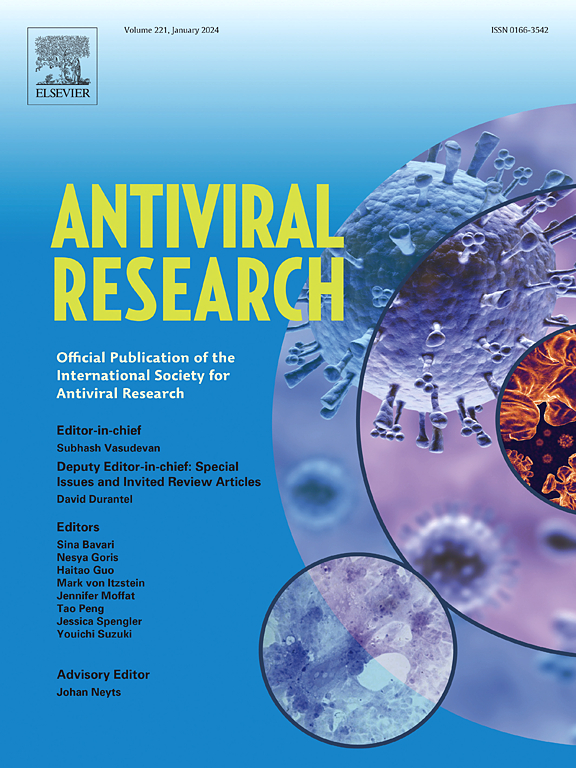Mechanism of entecavir-induced reduction of HBV DNA integration
IF 4
2区 医学
Q1 PHARMACOLOGY & PHARMACY
引用次数: 0
Abstract
Nucleos(t)ide analogues (NUC) treatment can reduce the extent of HBV DNA integration in chronic hepatitis B (CHB) patients. However, the mechanism by which NUC reduces HBV integration is unclear. This study investigated the effects of entecavir (ETV), one of the commonly used NUC, on cells with HBV integration. Full genome-length HBV DNA was inserted into HepG2 cell genome using the sleeping beauty transposon system. The resulting cells, named HepG2/SB/HBV, was subjected to ETV treatment. In ETV-treated HepG2/SB/HBV, intracellular HBV DNA was reduced by 2-fold. When treated with ETV, HepG2/SB/HBV had an impaired cell survival (25% reduction in cell proliferation rate when compared with untreated cells; p = 0.043). The median integration frequency in untreated HepG2/SB/HBV was 16 integration sites per 105 cells, which was reduced to 14.8 integration sites per 105 cells when treated with ETV. Analysis of the expression of apoptosis and mitosis markers showed that ETV-treated HepG2/SB/HBV had a reduced expression of mitosis markers phospho-cell division control-2 (p-cdc-2) and phospho-histone H3 (p-histone H3), but that of the apoptotic markers [Poly-ADP-ribose-polymerase] (PARP) and caspase-3 were not affected. In conclusion, ETV suppressed cell proliferation of hepatoma cells with HBV integration via interference of mitosis and reduced expression of p-histone H3, thereby reducing the number of HBV-integrated hepatocytes. This may be the mechanism by which HBV integration is reduced in CHB patients who received ETV therapy.
恩替卡韦诱导HBV DNA整合降低的机制。
核苷类似物(NUC)治疗可以降低慢性乙型肝炎(CHB)患者HBV DNA整合的程度。然而,NUC降低HBV整合的机制尚不清楚。本研究探讨了常用的NUC之一恩替卡韦(ETV)对HBV整合细胞的影响。利用睡美人转座子系统将全基因组长度的HBV DNA插入HepG2细胞基因组。将生成的细胞命名为HepG2/SB/HBV,进行ETV处理。在etv处理的HepG2/SB/HBV中,细胞内HBV DNA减少了2倍。当用ETV治疗时,HepG2/SB/HBV的细胞存活受损(与未治疗的细胞相比,细胞增殖率降低25%;P = 0.043)。未治疗的HepG2/SB/HBV的中位整合频率为每105个细胞16个整合位点,而接受ETV治疗的中位整合位点减少到每105个细胞14.8个整合位点。凋亡和有丝分裂标志物的表达分析显示,etv处理的HepG2/SB/HBV有丝分裂标志物磷酸细胞分裂控制-2 (p-cd -2)和磷酸组蛋白H3 (p-histone H3)的表达降低,但凋亡标志物[聚adp核糖聚合酶](PARP)和caspase-3的表达不受影响。综上所述,ETV通过干扰有丝分裂,降低p-组蛋白H3的表达,抑制HBV整合肝癌细胞的增殖,从而减少HBV整合肝细胞的数量。这可能是接受ETV治疗的CHB患者HBV整合降低的机制。
本文章由计算机程序翻译,如有差异,请以英文原文为准。
求助全文
约1分钟内获得全文
求助全文
来源期刊

Antiviral research
医学-病毒学
CiteScore
17.10
自引率
3.90%
发文量
157
审稿时长
34 days
期刊介绍:
Antiviral Research is a journal that focuses on various aspects of controlling viral infections in both humans and animals. It is a platform for publishing research reports, short communications, review articles, and commentaries. The journal covers a wide range of topics including antiviral drugs, antibodies, and host-response modifiers. These topics encompass their synthesis, in vitro and in vivo testing, as well as mechanisms of action. Additionally, the journal also publishes studies on the development of new or improved vaccines against viral infections in humans. It delves into assessing the safety of drugs and vaccines, tracking the evolution of drug or vaccine-resistant viruses, and developing effective countermeasures. Another area of interest includes the identification and validation of new drug targets. The journal further explores laboratory animal models of viral diseases, investigates the pathogenesis of viral diseases, and examines the mechanisms by which viruses avoid host immune responses.
 求助内容:
求助内容: 应助结果提醒方式:
应助结果提醒方式:


